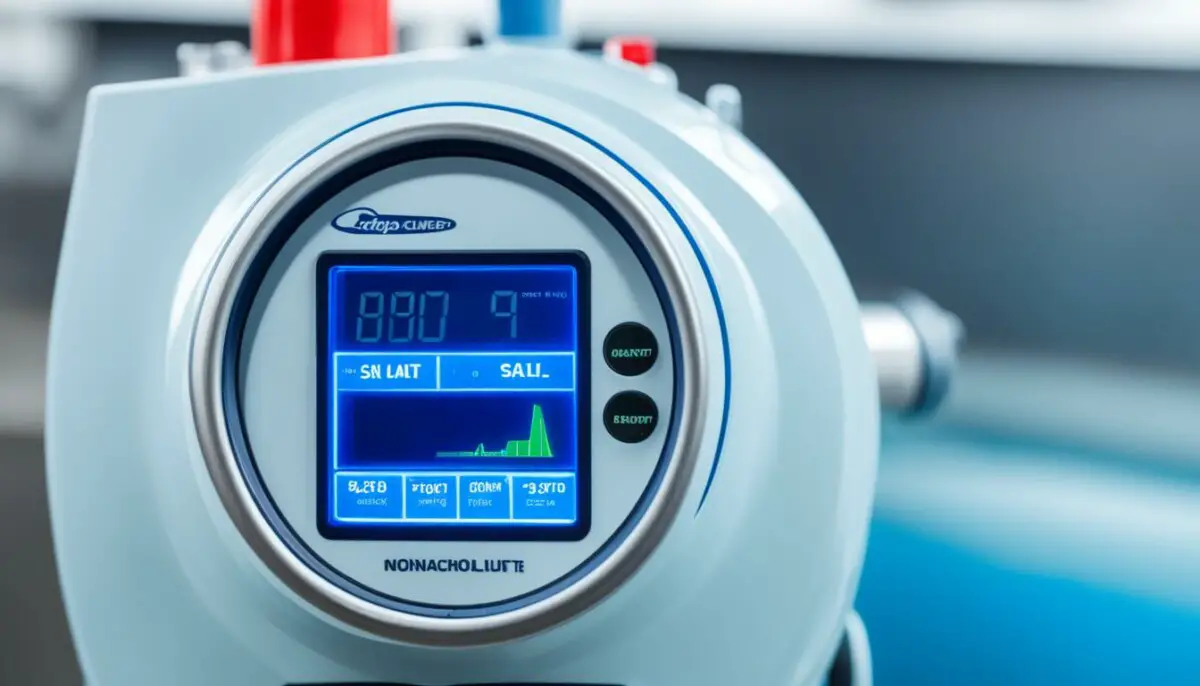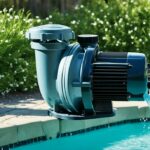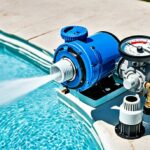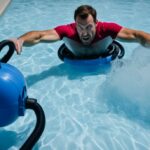Last Updated on 3 months by Francis
Are you experiencing low salt alerts with your salt chlorinator? Don’t worry, we’ve got you covered. Low salt alerts are a common issue that pool owners face with their chlorinators, but they can be easily resolved with some troubleshooting steps. In this article, we’ll discuss the reasons behind low salt alerts, how to troubleshoot and fix the problem, and provide some tips for maintaining optimal salt levels in your pool.
Contents
Key Takeaways:
- Low salt alerts indicate a salt level below the recommended range in your pool.
- Reasons for low salt alerts can include insufficient salt levels, dirty or clogged salt cells, incorrect cell type settings, and low water temperatures.
- To troubleshoot low salt warnings, check salt levels, clean the salt cell, ensure proper water flow, and monitor pH levels in your pool.
- Regular maintenance and adherence to manufacturer guidelines can prevent low salt alerts and ensure optimal chlorinator performance.
- Consult professional assistance if troubleshooting steps do not resolve the issue.
Reasons Why A Saltwater Chlorinator Stops Working
When it comes to saltwater chlorinators, there are several common reasons why they may stop working and trigger a low salt alert. Understanding these reasons can help pool owners troubleshoot and resolve the issues efficiently.
Insufficient Salt Levels
One of the primary reasons for a salt chlorinator not producing enough salt is low salt levels in the pool. The chlorine generator relies on a specific salt concentration to produce chlorine effectively. If the salt levels fall below the recommended range, the chlorinator may struggle to generate sufficient chlorine. Testing the salt level regularly using testing strips or kits and adding pool-grade salt as needed will help maintain the optimal concentration for chlorine production.
Dirty or Clogged Salt Cell
A dirty or clogged salt cell can also impede the chlorinator’s performance. Over time, minerals and debris can build up on the cell’s surface, hindering the electrolysis process. This can result in reduced chlorine production and trigger a low salt alert. Regularly inspecting and cleaning the salt cell according to the manufacturer’s guidelines will help ensure its efficiency.
Air in the Salt Cell
Air pockets in the salt cell can disrupt the power flow and lead to inaccurate readings, causing false low salt alerts. It is essential to ensure that the salt cell is filled with water properly, without any air trapped inside. Checking for any air pockets and releasing them if necessary will help prevent false low salt warnings.
Incorrect “Cell Type” Setting
Incorrectly setting the “cell type” on the chlorinator controls can also contribute to low salt errors. Different cell sizes require different settings to accurately measure and regulate salt levels. Verifying that the “cell type” setting matches the actual cell being used will help ensure accurate readings and optimal performance.
Low Water Temperatures
Low water temperatures can impact the overall performance of salt chlorinators. Cold water slows down the electrolysis process, which can lead to reduced chlorine production. During colder months or in regions with lower temperatures, it may be necessary to adjust the salt level or increase the chlorinator’s output to compensate for the lower efficiency.
Bad Cable Connection
A faulty or loose cable connection can interfere with the chlorinator’s operation and trigger low salt errors. Pool owners should inspect the cable connections, ensuring they are securely attached and undamaged. Replacing any damaged cables and ensuring proper connections will help maintain the chlorinator’s functionality.
The Need for Salt Cell Replacement
In some instances, a salt cell may reach the end of its lifespan and require replacement. Over time, the cell’s electrodes can wear out or become coated with mineral deposits, affecting its efficiency. If all other troubleshooting steps have been attempted without success, it may be necessary to replace the salt cell with a new one.
By understanding these reasons why a saltwater chlorinator may stop working, pool owners can effectively troubleshoot and address the issues that cause low salt alerts. Regular maintenance, proper cleaning, and adherence to manufacturer guidelines will help ensure the continuous and reliable operation of salt chlorinators.
Troubleshooting Low Salt Warnings
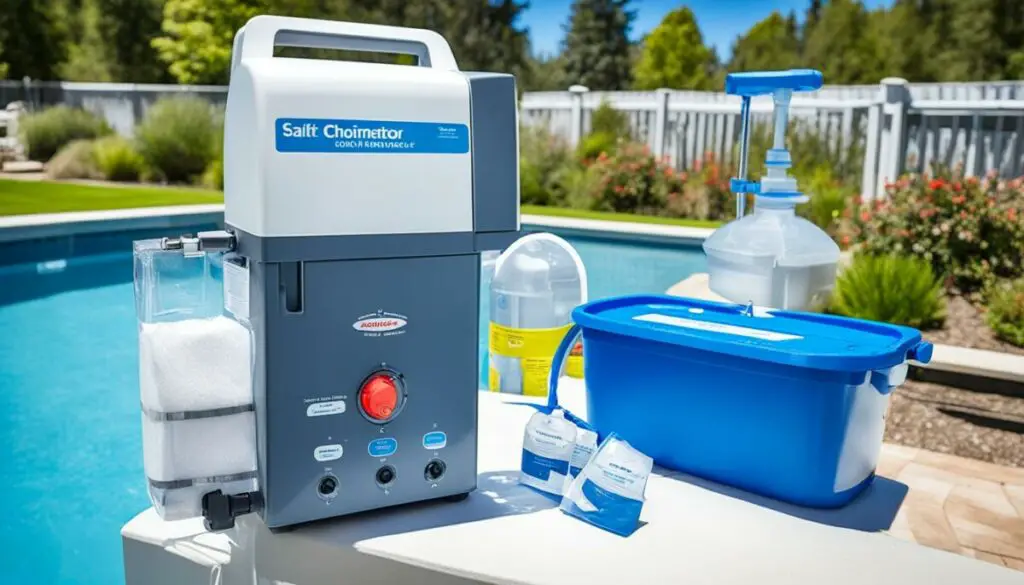
When faced with a low salt warning on your chlorinator, there are a few steps you can take to troubleshoot the issue:
- Check the salt levels in your pool using testing strips or kits. If the salt level is below the recommended range, add the necessary amount of pool-grade salt to bring it to the optimal concentration.
- Inspect the salt cell for any mineral scaling or debris buildup. Clean the cell according to the manufacturer’s guidelines to remove any mineral deposits.
- Ensure that the salt cell is fully filled with water and that all connections are secure.
- If the warning persists, check the “cell type” setting on the controls to ensure it matches the actual cell size being used.
- Lastly, consider the water temperature, as extremely cold water can affect chlorine production.
By following these troubleshooting steps, you can effectively address low salt warnings in your chlorinator and maintain optimal chlorine production for a clean and healthy pool.
| Issue | Troubleshooting Steps |
|---|---|
| Low salt level |
|
| Mineral scaling or debris buildup |
|
| Cell type setting mismatch |
|
| Water temperature |
|
Common Salt Chlorinator Problems and Solutions

Apart from low salt warnings, salt chlorinators can encounter other common problems. One issue is the chlorinator’s inability to accurately read the salt levels in the pool, leading to incorrect readings and warnings.
This problem can be caused by a faulty sensor or wiring issue. To resolve it, follow these steps:
- Check the sensor and wiring connections to ensure they are secure and properly connected.
- Clean the sensor if necessary, removing any dirt or debris that may be affecting its performance.
- Calibrate the sensor according to the manufacturer’s guidelines, ensuring accurate readings.
- Ensure that the sensor is fully immersed in the pool water, as insufficient immersion can result in inaccurate measurements.
Another common problem is the occurrence of a low salt warning even when the salt levels are within the recommended range. This can be a result of sensor malfunction or calibration issues.
If you have followed all the troubleshooting steps and the issue persists, it is advisable to contact the manufacturer’s technical support for further assistance.
To provide a visual representation of common salt chlorinator problems and their solutions, the table below offers a summary:
| Problem | Solution |
|---|---|
| The chlorinator is not reading correct salt levels | Check sensor and wiring connections Clean and calibrate the sensor Ensure proper immersion of the sensor |
| Low salt warning even when salt levels are within the recommended range | Contact manufacturer’s technical support for further assistance |
Having a better understanding of these common salt chlorinator problems and their solutions will help you troubleshoot issues effectively and ensure the proper functioning of your pool’s chlorinator.
Maintaining Optimal Salt Levels in Your Pool
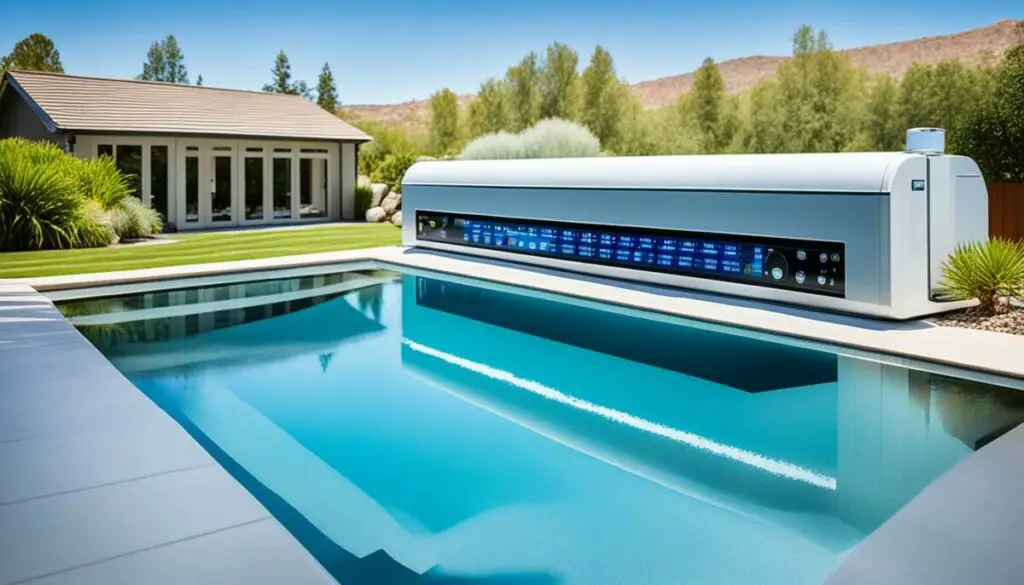
To ensure the efficient functioning of your salt chlorinator and prevent low salt warnings, it is essential to maintain optimal salt levels in your pool. Follow these steps to keep your pool’s salt levels in check:
- Regularly test the salt levels using testing strips or kits. Check the recommended salt range specified by the manufacturer.
- If the salt levels are low, add the necessary amount of pool-grade salt to reach the optimal concentration.
- Use refined salt specifically designed for pool use. Avoid adding salt directly into the skimmer. Instead, add it to the shallow end of the pool for even dispersion.
- Be aware of the water temperature, as colder water may require higher salt levels.
- Regularly maintain and clean the salt cell to prevent any salt buildup or debris accumulation.
By maintaining optimal salt levels in your pool, you can ensure that your salt chlorinator operates effectively and provides the necessary chlorine production for a clean and inviting swimming experience.
Preventing Mineral Scaling in Salt Cells

Mineral scaling is a common issue that can adversely affect the efficiency of salt cells in chlorinators. Over time, minerals can build up on the surfaces of the cell, inhibiting chlorine production. To prevent mineral scaling and ensure optimal performance of your salt cell, follow these steps:
- Regular Inspection and Cleaning: It is important to regularly inspect and clean the salt cell according to the manufacturer’s guidelines. This ensures that any mineral deposits are removed and the cell remains free from scaling. Use a cell cleaning solution recommended by your pool professional for effective results.
- Check Water Chemistry and Balance: High calcium levels in the pool water can contribute to scaling. Therefore, it is advisable to regularly check the water chemistry and balance in your pool. Proper water balance will help prevent the formation of mineral deposits on the salt cell, reducing the risk of false low salt readings.
- Regular Maintenance and Care: To prolong the lifespan of the salt cell and maintain efficient chlorine production, regular maintenance and care are essential. This includes keeping the cell clean, ensuring proper water circulation, and addressing any issues promptly.
By following these preventive measures, you can effectively minimize mineral scaling in salt cells and ensure consistent performance from your chlorinator.
| Benefits of Preventing Mineral Scaling |
|---|
| 1. Enhanced chlorine production |
| 2. Extended lifespan of the salt cell |
| 3. Reduced risk of false low salt readings |
| 4. Improved efficiency of the chlorinator |
Checking for Flow Issues in Salt Chlorinators
Flow issues can greatly impact the performance of salt chlorinators, leading to low salt warnings and inaccurate salt level readings. Insufficient water flow through the salt cell can disrupt chlorine production and affect the chlorinator’s functionality. To ensure optimal flow, it is essential to check various components of the pool system:
- Valves and Pump: Verify that all valves are properly functioning and open to allow adequate water flow. Check the pump for any malfunctions or clogs that may hinder water circulation.
- Salt Cell: Inspect the salt cell for any air pockets that could impede water flow. Air pockets can be released by gently tapping the cell or temporarily reversing water flow.
- Pump, Filter, and Skimmer: Clean these components thoroughly to remove any debris or blockages that may obstruct water flow. An obstructed system can result in reduced flow and affect the performance of the chlorinator.
- Salt Cell Age: Consider the age of the salt cell. Over time, the cell’s functionality may deteriorate, leading to improper flow. If the cell is worn-out, it may need to be replaced for optimal operation.
Regular inspection and maintenance of the pool system will help detect and resolve flow issues, ensuring that your salt chlorinator functions effectively and provides accurate salt level readings.
“A properly functioning salt chlorinator requires optimal flow of water through the salt cell. Regular inspection and maintenance of the pool system will help prevent flow issues and ensure accurate salt level readings.”
Maintaining Proper pH Levels in Your Pool
Proper pH levels are crucial for the efficient operation of salt chlorinators. When pH levels in your pool are too high or too low, it can impact chlorine production and result in low salt warnings or incorrect salt level readings.
To ensure optimal pH levels, it’s important to regularly test the pH of your pool using a photometer or test strips. Adjust the pH levels accordingly to fall within the recommended range specified for your chlorinator.
Take a moment to check the pH sensor wiring on the control box and sensor holder to ensure proper connectivity. A loose or faulty connection can affect the accuracy of pH readings. Make any necessary adjustments or repairs to maintain optimal performance.
Cleaning and calibrating the pH sensor, if needed, is also essential. Follow the manufacturer’s guidelines to properly clean the sensor and remove any build-up that may interfere with accurate readings. Consider using a pH sensor tester to verify the sensor’s operation.
By maintaining balanced pH levels, you can contribute to the efficient functioning of your salt chlorinator, ensuring optimal chlorine production and avoiding low salt warnings or inaccurate salt level readings.
| Benefits of Maintaining Proper pH Levels |
|---|
| Consistent chlorine production |
| Accurate salt level readings |
| Enhanced water quality and clarity |
| Reduced risk of algae growth |
| Extended lifespan of pool equipment |
“Maintaining balanced pH levels in your pool is crucial for the optimal functioning of your salt chlorinator.”
Conclusion
Troubleshooting low salt alerts in a salt chlorinator requires a systematic approach to identify and resolve the underlying issues. By checking and maintaining salt levels, inspecting and cleaning the salt cell, addressing flow issues, and monitoring pH levels, pool owners can prevent low salt warnings and ensure the proper functioning of their chlorinators. Regular maintenance, adherence to manufacturer guidelines, and expert assistance when needed will help maintain a healthy and well-sanitized pool environment.
To effectively troubleshoot low salt alerts, pool owners should first check the salt levels in their pool using testing strips or kits. If the salt level is low, adding the necessary amount of pool-grade salt will restore it to the optimal concentration. Inspecting and cleaning the salt cell according to the manufacturer’s guidelines is another important step to maintain optimal performance. Addressing flow issues by ensuring proper water flow through the salt cell and checking for blockages in the pump and filter is crucial for preventing low salt warnings.
In addition, monitoring pH levels and maintaining proper balance is essential for the efficient functioning of salt chlorinators. Pool owners should regularly test the pH levels and adjust them to the recommended range specified for their chlorinator. By following these troubleshooting steps and performing regular maintenance tasks, pool owners can enjoy a well-functioning salt chlorinator that keeps their pool water sanitized and healthy.
FAQ
Why is my salt chlorinator showing a low salt level alert?
A low salt level alert is triggered when the salinity of the pool water falls below the recommended range. This can happen due to insufficient salt levels, a dirty or clogged salt cell, air in the salt cell, incorrect “cell type” settings, low water temperatures, bad cable connection, or the need for salt cell replacement.
How can I troubleshoot a low salt warning on my chlorinator?
To troubleshoot a low salt warning, first, check the salt levels in your pool using testing strips or kits. If the salt level is low, add pool-grade salt to reach the optimal concentration. Clean the salt cell, ensure proper water flow, check the “cell type” setting, and consider the water temperature. If the issue persists, professional inspection and repair may be required.
What are some common problems with salt chlorinators?
Apart from low salt warnings, common problems with salt chlorinators include inaccurate salt level readings, low salt warnings despite correct levels, and flow issues. These issues can be caused by faulty sensors or wiring, sensor malfunctions or calibration issues, and insufficient water flow through the salt cell.
How can I maintain optimal salt levels in my pool?
To maintain optimal salt levels, regularly test the salt levels using testing strips or kits and add the necessary amount of pool-grade salt. Use refined salt designed for pool use and add it to the shallow end of the pool. Monitor the water temperature, as colder water may require higher salt levels. Regular maintenance and cleaning of the salt cell can also help prevent low salt issues.
How can I prevent mineral scaling in salt cells?
To prevent mineral scaling, regularly inspect and clean the salt cell according to the manufacturer’s guidelines. Use a recommended cell cleaning solution and check the water chemistry and balance in your pool. High calcium levels can contribute to scaling, so it’s important to maintain balanced water chemistry.
How can I check for flow issues in my salt chlorinator?
To check for flow issues, ensure that all valves and the pump are properly functioning and open. Check the salt cell for air pockets that may disrupt water flow. Clean any blockages in the pump, filter, or skimmer. Consider the age of the salt cell, as a worn-out cell may require replacement.
How can I maintain proper pH levels in my pool?
To maintain proper pH levels, regularly test the pH using a photometer or test strips. Adjust the pH to the optimal range specified for your chlorinator. Check the pH sensor wiring and clean and calibrate the sensor if needed. Balanced pH levels contribute to the efficient operation of the chlorinator.

